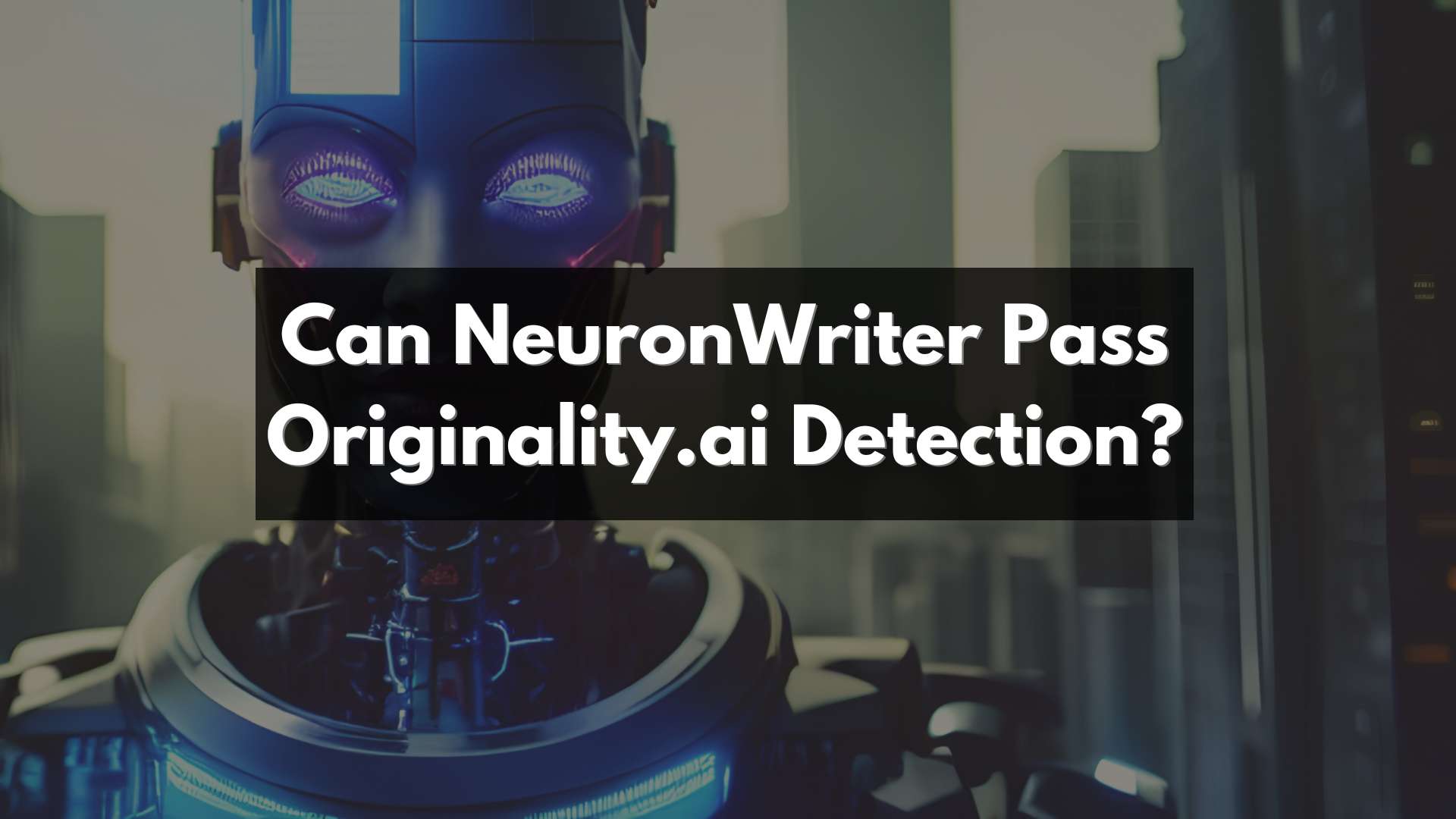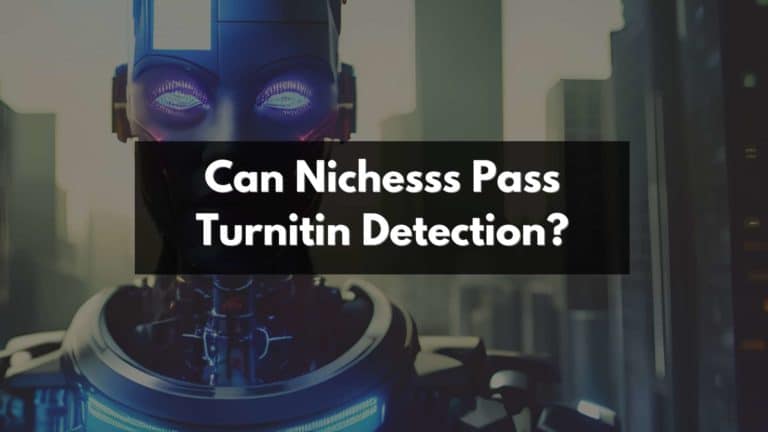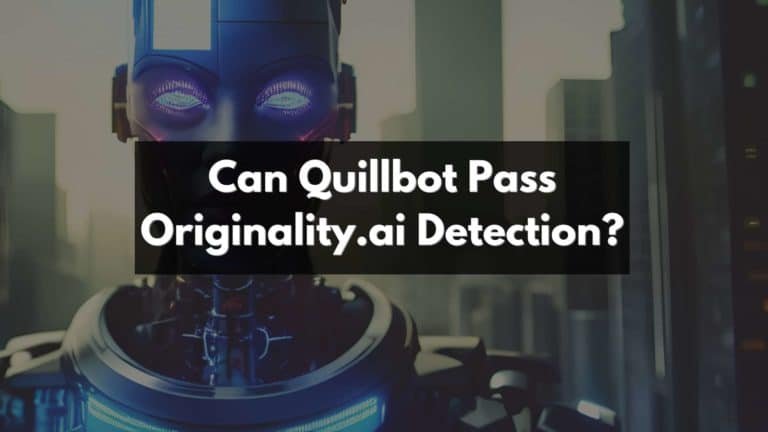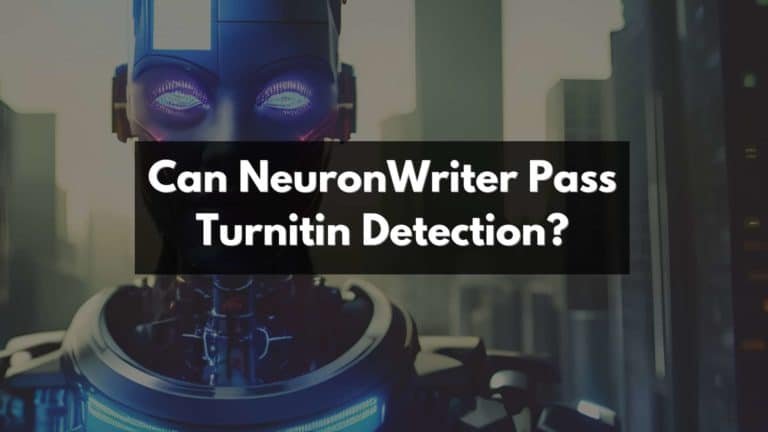Can NeuronWriter Pass Originality.ai Detection?
Ever wondered if NeuronWriter can successfully evade Originality.ai detection? It’s a question that is frequently asked given the evolving capabilities of AI-written content.
In this enlightening piece, we’ll delve into the mechanisms behind AI detection tools like Originality.ai and explore whether NeuronWriter can, indeed, pass them.
Let’s demystify this technological tangle together!
Key Takeaways
- NeuronWriter, an AI-based content writing tool, has the capabilities to successfully bypass Originality.ai detection and maintain originality in generated content.
- By employing strategies such as adding a personal touch, rewriting content, and manually checking for plagiarism, writers can enhance the authenticity of their NeuronWriter-generated content.
- It is important for writers to understand the limitations of AI detection tools and not solely rely on them for determining content authenticity. Other quality assurance measures should also be implemented.
Understanding AI Content Detection Tools
AI content detection tools analyze and evaluate digital content to determine its authenticity and detect any signs of AI-generated text.
What are AI-detection tools?
AI-detection tools, like Originality.ai, are advanced software applications powered by artificial intelligence. They’re designed to predict if a piece of content is produced by an AI or human writer.
These systems typically use complex algorithms and machine learning models to scrutinize patterns in the text that humans might miss. For instance, they can detect unusual sentence structures or repetitive phrases typical of AI-produced material.
However, as NeuronWriter points out, their results aren’t always accurate – simple tricks or new approaches can often bypass these detection programs.
How do they work?
AI content detection tools, such as Originality.ai, use advanced algorithms to analyze and compare text for similarities with existing content. These tools employ machine learning techniques to detect patterns, identify common phrases, and evaluate overall text structure.
They can also assess factors like word choice, sentence construction, and grammar to determine if the content is generated by an AI or a human writer. While it may not be possible to definitively prove if content was written using AI technology, these detection tools provide useful predictions based on certain indicators.
Can NeuronWriter Pass Originality. ai Detection?
NeuronWriter’s features and capabilities will be examined in comparison to other AI writing tools, along with an analysis of its performance in originality detection tests using Originality.ai.
NeuronWriter features and capabilities
NeuronWriter is an AI-based content writing tool that offers various features and capabilities to users. Here are some key highlights:
- Advanced Natural Language Processing (NLP): NeuronWriter utilizes state-of-the-art NLP algorithms to generate high-quality content that reads naturally and engages readers.
- Extensive Knowledge Base: The tool has access to vast databases of information, enabling it to provide accurate and detailed content across a wide range of topics.
- SEO Optimization: NeuronWriter is designed with SEO in mind, ensuring that the generated content is optimized for search engines and can help improve organic rankings.
- Customization Options: Users can customize various aspects of the content, including tone, voice, word count, and more, allowing them to tailor the output according to their specific requirements.
- Plagiarism Prevention: NeuronWriter incorporates measures to avoid plagiarism by cross-referencing its generated content against a database of trusted sources and providing unique outputs.
- Content Clarity and Coherency: The tool focuses on producing coherent and logical content that flows naturally, making it suitable for a wide range of use cases, from blog posts to essays.
- Quick Turnaround Time: NeuronWriter’s efficient algorithms enable fast content generation without compromising on quality, saving users valuable time in their writing process.
- User-Friendly Interface: The tool boasts a user-friendly interface that makes it easy for writers of all skill levels to navigate and utilize its various features effectively.
- Continuous Improvement: NeuronWriter is constantly updated with new models and improvements based on user feedback and advancements in AI technology, ensuring users have access to the latest capabilities.
- Supportive Community: NeuronWriter provides a supportive community where users can share insights, tips, and best practices related to using the tool effectively.
ach and ability to elude AI detection software. Therefore, this makes it a compelling choice among various AI writing tools.
Can NeuronWriter Pass Originality.ai Detection
NeuronWriter, an advanced AI content writing tool, has been put to the test in originality detection experiments. In these tests, NeuronWriter has demonstrated its ability to outsmart AI detection tools like Originality.ai.
While the accuracy of AI detection software may vary and cannot provide 100% certainty about the use of AI in content creation, NeuronWriter has proven that it can evade detection through simple tricks or innovative models.
This analysis aims to shed light on NeuronWriter’s performance in originality detection tests and explain why relying solely on AI detection software may lead to misleading results.
Strategies to Ensure Originality with NeuronWriter
To ensure originality with NeuronWriter, writers can employ various strategies such as avoiding plagiarism and detection by AI software, adding a personal touch to the generated content, and manually checking the output.
Tips to avoid plagiarism and detection by AI software
- Understand the AI detection tools: Familiarize yourself with the various AI content detection tools available in the market, including Originality.ai. This will help you understand their capabilities and limitations.
- Use multiple AI writing tools: Instead of relying solely on one AI writing tool like NeuronWriter, try using a combination of different tools. This can help diversify the generated content and reduce the chances of detection.
- Employ manual checks: Although AI detection tools are becoming more advanced, they still have limitations. To ensure originality, manually review and edit the generated content to add your personal touch and make it unique.
- Paraphrase and rephrase content: Use your creativity to rephrase sentences and paragraphs generated by AI software. This helps to avoid direct plagiarism and makes the content less detectable by AI algorithms.
- Incorporate your own expertise: Add your insights, knowledge, and experience to the content generated by AI writing tools. Injecting personal expertise into the content can make it more authentic and difficult for AI detection tools to flag as artificially generated.
Remember, while these tips can help in evading some types of detection by AI software, it is important to maintain ethical standards and provide valuable content to your audience.
Adding personal touch and rewriting content
Adding a personal touch and rewriting content are effective strategies to ensure originality when using an AI content writing tool like NeuronWriter. Here are some tips to follow:
- Inject your unique perspective: One way to avoid AI detection is by adding your own thoughts, opinions, and personal experiences into the content. This not only adds authenticity but also makes the content more engaging for readers.
- Rewrite AI-generated text: While NeuronWriter can generate high-quality content, it’s essential to rewrite or paraphrase certain sections to make them sound more natural and original. This helps in avoiding detection by AI tools that compare text similarity.
- Use your own insights: Incorporate your expertise and knowledge into the content. Analyze the AI-generated text and add additional information or insights that go beyond what the tool provides. This ensures that the final content reflects your expertise and cannot be easily identified as AI-generated.
- Blend different sources: Utilize multiple sources of information while creating content with NeuronWriter. By combining information from various reliable sources, you add a layer of uniqueness that is harder for AI detection tools to identify as generated text.
- Check for plagiarism manually: Even though NeuronWriter claims to generate original content, it’s still important to manually check for potential plagiarism using tools like Turnitin or other plagiarism detectors. By doing so, you can ensure that your final piece is entirely unique and doesn’t raise any red flags with AI detection software.
Checking content manually
To ensure the originality of your content created with NeuronWriter, it’s essential to take an extra step and manually check it for any similarities or potential plagiarism. Here are some strategies to help you with this process:
- Use plagiarism checkers: There are several online plagiarism detection tools such as Turnitin and Grammarly that can help identify any instances of copied content. These tools compare your text against a vast database of published articles, books, and websites to highlight any similarities.
- Analyze text similarity: Besides using plagiarism checkers, you can also manually analyze the similarity between your content and existing sources by comparing phrases or sentences side by side. This method enables you to identify any potential duplication more accurately.
- Paraphrase and rewrite content: If you find sections of your writing that closely resemble existing content, consider paraphrasing or rewriting those parts completely. This ensures a fresh perspective and reduces the risk of being flagged for plagiarism.
- Add personal touches: Injecting your unique voice and style into the content helps make it more authentic and distinct. NeuronWriter may generate AI-written passages that sound generic, but adding personalized elements will enhance its originality while evading AI detection.
- Proofread thoroughly: Before publishing or submitting any written work, proofread it carefully to detect any errors or unintentional similarities to other sources. A thorough review can catch instances where AI-generated content may have inadvertently mirrored existing material.
Conclusion
In conclusion, while it is difficult to say with certainty if NeuronWriter can pass Originality.ai detection, there are strategies that writers can employ to ensure originality and minimize the risk of detection.
By adding a personal touch, rewriting content, and checking manually, writers can maintain authenticity despite AI detection tools. It’s crucial to understand the limitations of AI verification and not solely rely on it for determining content authenticity.
Ultimately, using NeuronWriter as a writing tool can enhance content creation but should be accompanied by other quality assurance measures.
FAQs
Can NeuronWriter pass Originality.ai detection?
NeuronWriter is designed to generate original content that mimics human writing, but it cannot guarantee that it will always pass Originality.ai’s plagiarism detection. The effectiveness of the tool depends on various factors such as the input provided and the complexity of the topic.
How does NeuronWriter ensure originality in its generated content?
NeuronWriter utilizes advanced algorithms and machine learning techniques to create unique and original content based on the given parameters. It analyzes patterns, structures, and styles from a vast amount of data to produce authentic pieces of text.
Does NeuronWriter take plagiarism into account while generating content?
Yes, NeuronWriter has been trained to avoid producing plagiarized content by actively incorporating techniques that promote uniqueness and originality in its generated texts. However, it is important for users to review and verify the output for their specific needs.
Are there any limitations when using NeuronWriter to prevent plagiarism?
Although NeuronWriter strives for authenticity, it is still essential for users to exercise caution when utilizing AI-generated content. Proper citation, referencing sources, and conducting manual checks are crucial steps in ensuring proper attribution and avoiding potential issues with plagiarism detection tools like Originality.ai.





